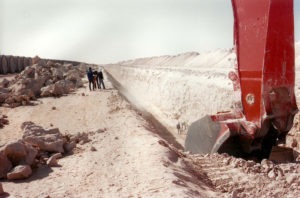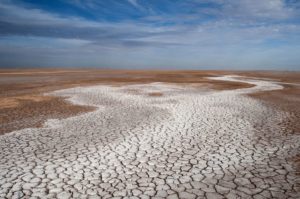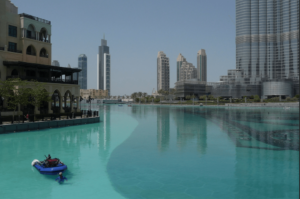
On April 11, 2020, a band of fighters stormed and seized a water control station in the Libyan Sahara. Taking employees prisoner, they occupied a key nexus that helps move 1.2 million cubic meters (317 million gallons) of water per day — 480 Olympic-sized swimming pools — from freshwater aquifers beneath the desert down to the coast.
The raiders flipped a switch and at a stroke, 400 kilometers (250 miles) away, in the capital Tripoli, 2 million people’s taps went dry.
One of many such attacks, this battle in the intensifying global water wars has dire portent for Libya and the world.
The country’s water system had once been a crown jewel of 20th century hydraulic engineering, part of a global constellation of megaprojects that allowed cities in water-starved regions to grow into the millions.
In the 1980s, with Libya’s coastal cities outpacing the region’s sparse rainfall, and its aquifers depleted by overuse, tainted by pollution, and salted by rising seas, Colonel Moammar Gadhafi completed an enormous network of pipes — the so-called Great Manmade River — linking desert aquifers and urban coasts; it now supplies 70% of Libya’s water.

The Manmade River today demonstrates just how fast a world-ranked freshwater supply system can fall apart.
Two decades of sanctions, conflict, and economic depression shifted Libya from being a state rich in water, to one vulnerable to going dry. Shutdowns by militants aside, the Manmade River’s current flow is just two-thirds its Gadhafi-era peak. And if that flow dips low enough, or is shut down for too long, the U.N. warned, the entire national water grid could fail causing an instant, exponential exacerbation in an ongoing humanitarian crisis.
But that shutdown would only hurry disaster. In fact, even Libya’s presently tapped Sahara aquifers are now running dry. Keeping the coast watered will demand new desert wells and more pipelines, which in turn demands more capital and enhanced security.
Libya’s coastal cities, where the vast majority of the country’s 6 million citizens live, thus face a fundamental existential crisis: they could wither and die, with oceans of distant underground water monetarily out of reach.
And Libya is not alone.
Phoenix: Sipping from long, long drinking straws
The Libyan case study is an advanced example of the world’s gathering water crisis — a crisis that could threaten 21st-century civilization itself as we approach a freshwater over-consumption planetary boundary.
The situations in arid and semi-arid cities like Phoenix, Arizona; Bamako, Mali; or Dubai, UAE, differ in their particulars, but rhyme in their impending disastrous trajectory. These, and other arid-region cities, are approaching the edge of an ecological cliff: dependent on sustaining growth, which itself requires a growth in water supplied by faraway and finite sources, and delivered by aging infrastructure.
But water in dryland regions is getting scarcer and supplies more unpredictable. Cities are competing with the agribusiness that feeds them, but which wastes water at astounding rates.

Phoenix exemplifies the paradox of a modern desert city — betting on an expanding population and booming economy while the land around it dries up. The city, Mayor Kate Gallego has said, “was born to grow,” and its population is expected to double to 3.4 million by 2040. Which makes it like many semi-arid and arid U.S. cities, including Dallas/Fort Worth and Los Angeles — all expected to boom as water supplies shrink.
This paradox is often framed as a problem of supply: as in, when will Phoenix run out of water? But as water policy expert Asit Biswas has said, “Water isn’t scarce — management is.”
Humanity’s historical use of water is, well, liquid: demand expands to wasteful levels when there’s oversupply, and shrinks in scarcity. This boom-or-bust mentality is ancient, observable in the ruins of the oldest Mesopotamian cities, or Southwestern U.S. abandoned pueblos, which rose and fell on their water supply.
Ironically, the political consensus in water-strapped High Plains, Texas, and Southern California has been to treat the commodity as effectively infinite. The regions’ cities grow by hydraulic deficit spending, whose bill will eventually come due.
In arid U.S. West municipal pricing schemes, consumers don’t pay for water, but rather the space to hold it, the land it lies under, or the energy to move it. Precious, irreplaceable, and essential though it may be, water is treated by the economic system as free and limitless.
That is in part because, the U.S., like Europe and the Middle East, spent the 20th century building water mega-projects — reservoirs, dams, canals, aqueducts, pipelines — to make it artificially plentiful.

The Salt River Project-Navajo Generating Station. The Salt River Project and Great Society-era Central Arizona Project draw water from the Salt and Colorado rivers, which in turn are sourced from the northern Arizona snowpack. Image by Krzysztof Belczyński via Flickr (CC BY-SA 2.0).
Far-flung desert aqueducts let Phoenix grow; the Salt River Project and Central Arizona Project siphon water from the snowpack down to the cities below. Since Arizona’s Colorado River water allotment goes to California if not used (a disincentive for thrift), the city has spent $330 million thus far to refill underground “water banks,” storing 3.6 million acre-feet of water (4.44 billion m3, or nearly 1.8 million Olympic-size swimming pools, and a year of Arizona’s Colorado River allotments) against future drought.
But the Colorado River’s flow, and therefore Phoenix’s current water supply, relies on snowpack — which is growing susceptible to climate change. According to the U.S. Environmental Protection Agency (EPA), snowfall in the Southwest region has been decreasing for 50 years, along with yearly streamflows. Meanwhile, snowmelt is happening ever earlier, as is the pulse of maximum streamflow. In 2015, California saw its smallest April snowpack in 65 years — just 5% of the area once usually covered.
Add that to the fact that the Colorado River is the most over-allocated river in the country. It goes dry miles shy of Mexico’s Sea of Cortez, creating an international water conundrum, not unlike that occurring in Jordan around the Dead Sea.
 No saving GRACE
No saving GRACE
During the U.S. West’s 2004-2013 drought, 50 cubic kilometers of groundwater (12 cubic miles, the equivalent of a column of water a mile across and twice the height of Mount Everest) vanished from the Colorado River Basin. Such immense hidden losses of groundwater, rather than declines in the great reservoirs of Lake Powell and Lake Mead (especially threatened this year), accounted for 80% of the region’s water loss.
Those numbers came from NASA’s GRACE satellite mission, which records changes in Earth’s gravitational field to estimate changes to its water supplies. Another GRACE study found that overuse is rapidly depleting 19 key aquifers, including the Ogallala Aquifer under the U.S. High Plains, as well as some California aquifers. Study co-author James Famiglietti wrote that several are “already past sustainability tipping points,” in danger of collapse into toxicity and brackishness. He estimates that the southern Ogallala Aquifer, supplying the Texas Panhandle, is within 25 years of collapse. Water shortages, NASA scientists concluded, will be the main environmental challenge of the century — an opinion shared by the U.S. Department of Defense.
There is no obvious replacement once that supply is gone. And the booming cities of Central Texas, including Dallas/Fort Worth and Austin, don’t even have aquifers. They make do with surface water flow, stored in massive reservoirs. But, warned a team of Texas A&M scientists, the remainder of the 21st century is likely to hold “megadroughts,” decades-long dry spells harsher than anything Texas has seen in 1,000 years. Dry spells faced by a state currently adding 1,000 people per day to its population.
Middle East salty solutions
The water crisis looming for the U.S. West has already arrived in today’s Middle East. Key aquifers, like that beneath the Arabian Peninsula, are in decline; war and infrastructure destruction have brought heightened scarcity to places like Iraq and Lebanon. The Nile and Euphrates rivers, 80% of which go to agriculture, now go dry far from the sea, like the Colorado. The Tigris River will soon join them.
The arid region’s difficulties are compounded by the fact that almost 82% of its wastewater is allowed to run into the sea. A rare bright spot is Oman, on the Persian Gulf, which draws 86% of its water from desalination, but then holds on to it as long as it can, treating and reusing 80% of its wastewater — twice that of the Gulf states in general. Bring regional conservation numbers up to the Omani level, experts say, and supplies could receive a boost with no new inputs at all.
But with surface flows dwindling, and aquifers tainted or depleted, Middle Eastern water still has to come from somewhere — which for the wealthy Gulf states means the ocean. Half the world’s desalination capacity rings the shores of the Persian Gulf, watering cities like Dubai, UAE, and Muscat, Oman, with artificially generated freshwater produced via reverse osmosis or by thermal distillation of saltwater.

As a result, in today’s Oman, Kuwait, Saudi Arabia and Qatar — nations that get just a couple of inches of rain yearly — people see water as plentiful. But generating a cubic meter (264 gallons) of freshwater by reverse osmosis requires 3-10 kilowatt-hours of electricity, which, in this case, comes from natural gas. This in turn drives the very climate change that is making Middle Eastern drylands drier, and maybe uninhabitable by 2050.
Then there is the salt slurry pulled from seawater to render it fresh. Runoff from the Gulf’s more than 850 desalination plants, several studies have found, has already raised salt levels in the Persian Gulf, poisoning coastal ecosystems, and will likely double salt levels yet again in some areas by 2050.
The entire desalination process is “sustained unsustainability,” said a professor of public policy at the Doha Institute for Graduate Studies. There’s also the Middle East wild card: conflict. ISIS, the failed proto-state, for example, deliberately destroyed irrigation systems and dams, while water supplies are almost certain to be targets for destruction or conquest in future wars.


